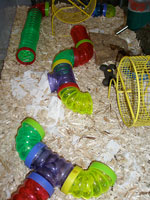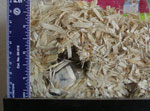Roborovski Dwarf Hamsters: Habitat
Roborovski Dwarf Hamsters Origin
Roborovski hamsters live in the wild around the Gobi Desert, throughout Mongolia's desert steppe and parts of northern China. They are particularly suited to the steppe, as they are highly efficient in their use of water (as evidenced by how they may pass particularly concentrated urine), so little vegetation is required. Here, they dig and live in burrows. These are usually steep tunnels and they live between 60 and 200 cm (~24 to 79 inches) below ground.
Roborovski Dwarf Hamsters as Pets
Roborovski hamsters are very curious, easily startled, and generally timid, as well as very active. They also don't speak or squeak as much as most hamster species. For some, if enclosed in a hand, will bite or nip in attempt to escape.(They usually put their hands in the position for eating when they try to bite you! So be alarmed.) Some will even sniff around and nip. These behaviors are rare but possible. They benefit from an enriched environment they can be active in. Roborovskis can be hand-tamed if acquired young and individually accustomed to handling. This requires some patience and time investment, however, since they bite often when angry. A hamster can easily hurt itself escaping or getting into the wrong places before it is caught. It is important to handle them where they cannot get away as they are hard to catch, being both fast and very small, and will not hesitate to wriggle free or jump from their owner's hand if panicked, no matter the distance to the ground.
Roborovski hamsters can enjoy being together. Two of these hamsters from different litters may get along if introduced properly, although there is always a chance they may not. It is common for this breed to be extremely vicious, especially with each other. They are very territorial and fights can lead to death. Compatible cage mates will generally play, eat, and sleep together in the same spot. Their antics are constantly entertaining and they make excellent pets for those who want animals that are fun to watch and require less personal handling.
Although generally nocturnal, they are more likely to be active during the day than the more commonly-kept Syrian hamster (Mesocricetus auratus). They do not, however, like direct light or sunlight and will be more confident emerging in the daytime if their home can be kept in relative shade. Like most other small animals, these hamsters cannot see by red light. Therefore, a "fireglow" bulb installed by their cage or tank, though offering little visibility to them, will illuminate their night-time behavior for fascinating observation. Roborovski hamsters have been reported running up to 20 miles a night in about 8 and a half hours.Robo Dwarf hamsters make a good pet.
Many types of housing is available at pet stores, however the best option is an aquarium with a wire mesh top. Plastic enclosures can retain hamster waste fumes, causing respiratory problems. Wire cages often have openings large enough for these tiny hamsters to squeeze through.
When choosing an aquarium, the larger the aquarium, the better. Many books and websites mention 10 gallon aquariums since they are inexpensive, but for even 1 hamster, the space provided is too small. The picture on the right is a 40 gallon (breeder) aquarium. One running wheel per hamster is provided to reduce possible aggression. This size of aquarium allows for the hamsters to use the wheels or even run around the aquarium, which is common behavior that can be observed. The volume of the aquarium is not as important as the footprint. Measure the length and width to see how many square inches/centimeters your hamsters will have available. Check on craigslist for used so you can get a large enough aquarium for a low price.
Setting Up a Habitat
In captivity as pets, the smallness of this animal precludes the use of heavily-scented wood-based cage-litters such as pine or cedar, the former of which can lead to itching, sneezing and even severe allergic reaction and the later of which may lead to death. Catlitter makes a good alternative. Paper-based beddings are encouraged, with aspen shavings usually now being regarded as the only safe wood-based choice. When setting up the habitat, be sure to add enough bedding to allow your hamsters to burrow below the surface (see picture to the right). A depth of 3 inches (~8 cm) or more provides sufficient space for your hamsters to create their own cozy nest underground.
Commercial "fluffy" beddings, usually made of cotton or similar material, have come under some controversy as possibly being damaging to stomach or intestines if swallowed. While paper-based or aspen bedding is used to give the hamster burrowing opportunities while providing odor control, plain toilet tissue is recommended as a nesting material to be used in addition to the "ground cover" of bedding. Notice the toilet tissue on the bottom of the hamster habitat on the right.
Multiple owners find that the use of bathing sand is helpful. Chinchilla bathing sand can be found in most pet stores, although bathing dust is too fine and can thus cause resperitory problems. Bathing sand helps in improving coat and restoring oils in the fur. Bathing a hamster in water is not encouraged, as it is unhealthy for their skin and water removes needed oils. Without those oils any hamster could die easily from cold.
To adopt a Roborovski Dwarf Hamster, check with your local shelter or rescue group first. Just like cats and dogs, you can rescue a hamster that needs a home and have one of the cutest pets available.
Hamsters prefer dark places. Dwarf hamsters also can run extremely quickly.
List of Supplies
Here is a list for a comfortable habitat setup for your hamster(s):
- Aquarium - at least 20 gallon long (75 liters) and mesh cover or other type of habitat
- water bottle and holder
- running wheel
- food
- food bowl
- bedding
- plastic tubing
- igloos or other small housing
- and of course, a hamster
Click on Pictures Above to Zoom In Last Updated: 11 April 2025

